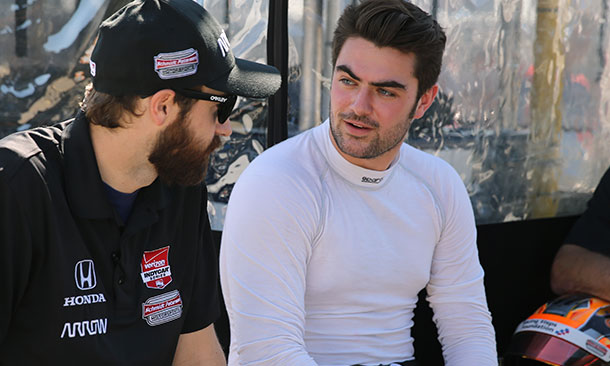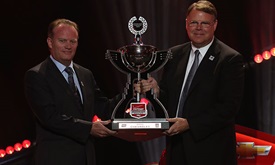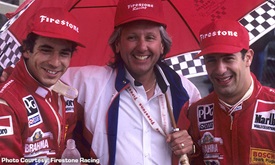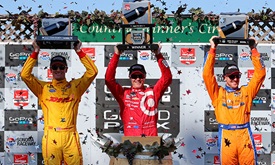Scholarship aids transition to next level
SEP 06, 2015
Last of three parts looking at the 30th season of Indy Lights
Circumstances are similar, though the setting is different, this weekend for Jack Harvey, who will attempt to clinch the Indy Lights Presented by Cooper Tires championship.
Last year at Sonoma Raceway, Harvey tied on points with Gabby Chaves through 14 races. Chaves, driving for Belardi Auto Racing, captured the series title in a tiebreaker based on more second-place finishes.
Harvey, 22, of England, takes a six-point lead over American Spencer Pigot into the two races Sept. 12-13 at Mazda Raceway Laguna Seca. Ed Jones, RC Enerson and Max Chilton also are within 78 points.
“Last year, I had two poles and two wins in the last race weekend of the year so I feel very confident in what I can achieve as a driver and I’ve got massive belief in my team,” the Schmidt Peterson Motorsports with Curb-Agajanian driver said. “It’s just down to me and my team to get the job done. Winning the championship would definitely help our cause progressing forward into IndyCar.”
That’s been Harvey’s goal since moving to the States in 2014 after finishing fifth and earning top rookie honors in the GP3 Series in 2013. In 2012, he won the Cooper Tires British Formula 3 International Series.
Click it: Rich history || Series develops future stars
The 2015 champion will be awarded a $1 million scholarship toward the Verizon IndyCar Series with three guaranteed races, including the 100th Running of the Indianapolis 500.
Indy Lights’ rich history includes 100-plus graduates to Indy car racing, including dual champions Paul Tracy, Scott Dixon and Tony Kanaan. Each credited Indy Lights with providing the platform necessary to transition to the bigger, faster cars.
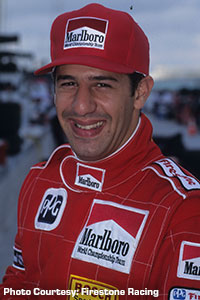 “When I came from Europe to race here in the U.S., I had zero experience with the tracks or with the Lights car. With the help of my Lights team, I was able to succeed, finishing my first season in second place and clinching the championship in my second year,” said Kanaan (1997 photo, right).
“When I came from Europe to race here in the U.S., I had zero experience with the tracks or with the Lights car. With the help of my Lights team, I was able to succeed, finishing my first season in second place and clinching the championship in my second year,” said Kanaan (1997 photo, right).
“It was my steppingstone to Indy car and, when I made it to the big boys’ league, I had to hit the ground running in order to keep up with the level of the drivers already there. Fortunately, I did well and earned the Jim Trueman Rookie of the Year Award.”
That was in 1998, and Kanaan went on to earn the 2004 Verizon IndyCar Series championship and won the 2013 Indianapolis 500 among 17 victories.
Pippa Mann, who also competed in two Indy Lights seasons, said the experience on ovals was especially beneficial.
“When I was running in Indy Lights in 2010, I had a really great team with Sam Schmidt Motorsports and I had a pretty good year,” said Mann, who competed in six Verizon IndyCar Series oval races this season with Dale Coyne Racing. “I was able to run up front quite a bit and the results I had that year on the ovals, still five years later, that’s what has resulted in me getting these chances.
“Because in Indy Lights I ran well on these kind of tracks that stands me in great stead over someone who never ran Indy Lights.”
The new-for-2015 chassis-engine package, which includes technology such as push-to-pass that is utilized in the Verizon IndyCar Series, also provides relevance and aids drivers seeking to make the transition to the more powerful and faster Verizon IndyCar Series car.
In conjunction with Verizon IndyCar Series teams in accordance with the Verizon IndyCar Series rulebook, Harvey and six other Indy Lights drivers tested in Verizon IndyCar Series cars Aug. 13 at Sonoma Raceway. The program, which will expand for 2016, provided an opportunity for drivers to further get acclimated to the car.
“I expected the IndyCar to feel very different from the Indy Lights car, but it didn’t,” Harvey said. “The Mazda engine in the Indy Lights car, coupled with the extra turbo, you do experience that feeling of your body being pushed back into the car. That was good preparation for the IndyCar. I was able to jump into the IndyCar and feel comfortable with the speed.
“Mazda has done a fantastic job of giving us an engine that will help us take that next step. And Dallara delivered a great car. It’s much closer in style to the IndyCar than the old car.”
Such synergy is important with the expanding technology in the Verizon IndyCar Series cars, while the Indy Lights program as a whole remains a key component in developing race craft.
“There’s a long list of things that without Indy Lights would not have been possible,” said Dixon, the 2000 Indy Lights champion who on Aug. 30 wrapped up his fourth Verizon IndyCar Series title. “There were some guys who kind of jumped in (to Indy cars) but they also struggled for quite some time until they got the knack of it.
“With Indy Lights, I kind of eradicated that. I wouldn’t be where I am today without Indy Lights.”










